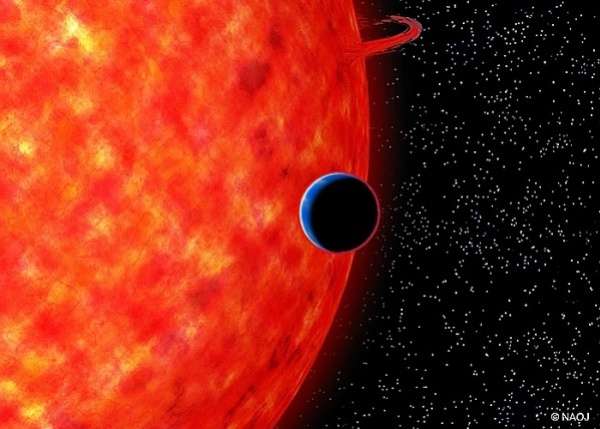A blue, neptune-size exoplanet around a red dwarf star

A team of astronomers have used the LCOGT network to detect light scattered by tiny particles (called Rayleigh scattering), through the atmosphere of a Neptune-size transiting exoplanet. This suggests a blue sky on this world which is only 100 light years away from us. The result was published in the Astrophysical Journal on November 20 (and is available on ArXiV).
Transits occur when an exoplanet passes in front of its parent star, reducing the amount of light we receive from the star by a small fraction. When the orbit of an exoplanet is aligned just right for transits to occur, astronomers can measure the planet's size at different wavelengths in order to generate a spectrum of its atmosphere. The spectrum then reveals the substances present in the planet's atmosphere, and therefore its composition. This measurement is most often performed using infrared light, where the planet is brightest and most easily observed. During the last few years, researchers have been probing the atmospheres of several small exoplanets with large ground and space-based telescopes, but have found it challenging to determine their composition using this method. This is either because the planets have clouds (which obscure the atmosphere) or because the measurements were not sufficiently precise.
At four times the size of the Earth, GJ 3470b is a transiting exoplanet closer in size to our own planet than to the hot Jupiters (about 10 times the size of the Earth) which so far make up the majority of exoplanets with well-characterized atmospheres. Astronomers led by Diana Dragomir of the University of Chicago have followed up on a discovery by a different group, whose results tentatively hinted at the presence of Rayleigh scattering in the atmosphere of GJ 3470b. Dr. Dragomir's team acquired and combined transit observations from all of LCOGT's observatory sites (Hawaii, Texas, Chile, Australia and South Africa) to conclusively confirm the detection of Rayleigh scattering for GJ 3470b.
The result is significant for several reasons. GJ 3470b is the smallest exoplanet for which a detection of Rayleigh scattering exists. While this planet is also believed to be cloudy or hazy, the measurement tells astronomers that the planet has a thick hydrogen-rich atmosphere below a layer of haze which scatters blue light. Indeed, the sky is blue on GJ 3470b. Moreover, the planet orbits a small (red dwarf) star, which means it blocks a large amount of light during every transit, making the transit easier to detect and the planet more easily characterisable. Finally, this measurement is the first clear detection of a spectroscopic feature in the atmosphere of an exoplanet that was made only with small (1.0m and 2.0m) telescopes. The team has also supplemented the LCOGT data with observations obtained from the 1.5m Kuiper Telescope in Arizona.
Dr. Dragomir, who carried out the project while she was a researcher at LCOGT, says that "this detection brings us closer to understanding the nature of increasingly smaller exoplanets through the use of a novel approach which allows us to probe the atmospheres of exoplanets even if they are cloudy." At the same time, the result highlights the role that meter-size telescopes can play toward characterising the atmospheres of these worlds.
More information: "Rayleigh Scattering in the Atmosphere of the Warm Exo-Neptune GJ 3470b," Diana Dragomir et al., 2015, Astrophysical Journal iopscience.iop.org/article/10. … /0004-637X/814/2/102 , Arxiv: arxiv.org/abs/1511.05601
Journal information: Astrophysical Journal , arXiv
Provided by Las Cumbres Observatory Global Telescope Network





















